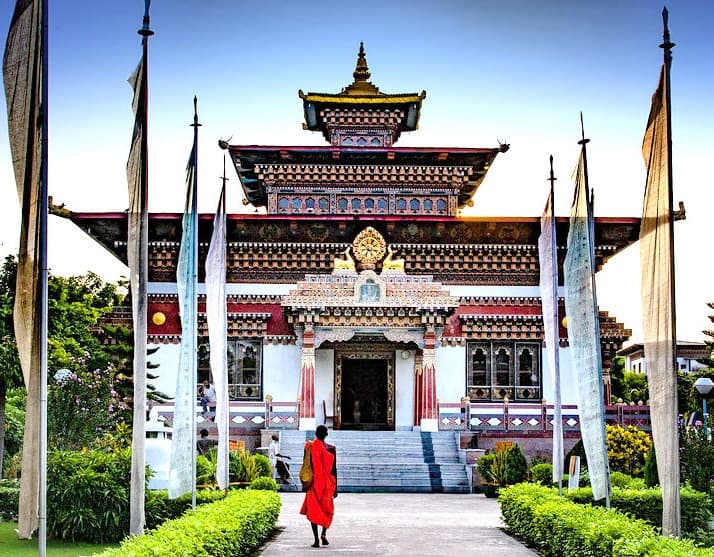Bhutan's high-altitude treks offer a unique blend of breathtaking landscapes, rich cultural heritage, and spiritual enlightenment, making it a premier destination for adventure seekers worldwide. With treks like the challenging Snowman Trek, the spiritually enriching Jomolhari Trek, and the scenic Druk Path Trek, Bhutan caters to a variety of preferences and skill levels. These treks not only present opportunities to witness the pristine beauty of the Himalayas but also to immerse oneself in the deep-rooted Buddhist traditions of the kingdom. Whether you're a seasoned trekker or someone looking to explore the untouched wilderness of Bhutan, the country's high-altitude adventures promise an unforgettable experience amidst the clouds.
At Druk Holidays, we specialize in guiding you through Bhutan's most stunning high-altitude treks. Our deep connection with Bhutan's landscapes and culture ensures that your trekking adventure, whether it's the challenging Snowman Trek, the spiritual Jomolhari Trek, or the picturesque Druk Path Trek, is not just a journey, but a lifetime experience. Our team of experienced guides and well-planned itineraries make Druk Holidays your go-to partner for discovering the breathtaking beauty and serene spirituality of Bhutan's high-altitude wonders. Join us to explore the clouds and beyond in the heart of the Himalayas with ease and expertise.
Trekking in Bhutan offers a unique blend of experiences that are both enriching and distinctive compared to other trekking destinations worldwide. Here are compelling reasons why you should consider Bhutan for your next trekking adventure:
- Pristine Natural Beauty: Bhutan's strict environmental policies have preserved its landscapes in nearly pristine condition. Trekking in Bhutan allows you to explore untouched forests, high-altitude meadows, and crystal-clear rivers, all set against the backdrop of the stunning Himalayas.
- Cultural Authenticity: Bhutan has managed to preserve its cultural heritage in the face of globalization, providing a rich, authentic experience for visitors. Trekking routes often pass through remote villages and near ancient monasteries, offering a glimpse into the traditional Bhutanese way of life and deep-rooted spiritual practices.
- Spiritual Experience: Bhutan is deeply Buddhist, and this spirituality permeates every aspect of its society. Many treks lead to sacred sites, monasteries, and temples that are active centers of worship. The tranquil environment and the spiritual nature of the sites offer a peaceful and introspective experience, unlike typical trekking destinations.
- Exclusive and Unspoiled Trails: Due to Bhutan’s controlled tourism policy, which includes a daily tariff, the trails are never overcrowded. This policy helps maintain the tranquility and exclusivity of the trekking experience, allowing for a more personal connection with nature and ensuring that trek paths remain unspoiled.
- Diverse Trekking Options: Whether you are looking for a challenging high-altitude trek like the Snowman Trek, which is known as one of the toughest in the world, or something less strenuous but equally rewarding like the Druk Path Trek, Bhutan offers a range of options that cater to different fitness levels and trekking preferences.
- Commitment to Sustainability: Bhutan is the only country in the world that is carbon negative, reflecting its commitment to sustainability. Trekking in Bhutan is an opportunity to support and learn from a nation that prioritizes environmental conservation in its tourism practices.
- Safe and Structured Travel: The requirement to book through registered tour operators ensures that all logistics are taken care of, including travel permits, accommodation, and knowledgeable guides. This structured approach to tourism helps ensure the safety and comfort of all visitors.
- Unique Wildlife: The Himalayan ecosystem is home to unique species that are rarely seen elsewhere, such as the takin (Bhutan’s national animal), the snow leopard, and the black-necked crane. Trekking in Bhutan can sometimes afford sightings of these rare animals in their natural habitats.
Trekking in Bhutan is not just about the physical journey; it's a comprehensive experience that offers breathtaking natural beauty, profound cultural interactions, and a chance to engage with an environment that has been carefully protected for generations. This combination of factors makes Bhutan a truly exceptional destination for trekkers around the world.
Top High-Altitude Treks in Bhutan:
Snowman Trek
The Snowman Trek in Bhutan is one of the most challenging and exhilarating high-altitude treks in the world. Known for its extreme conditions and breathtaking beauty, it is a test of endurance and spirit, attracting seasoned trekkers seeking the ultimate adventure. Here are some key details about the Snowman Trek:
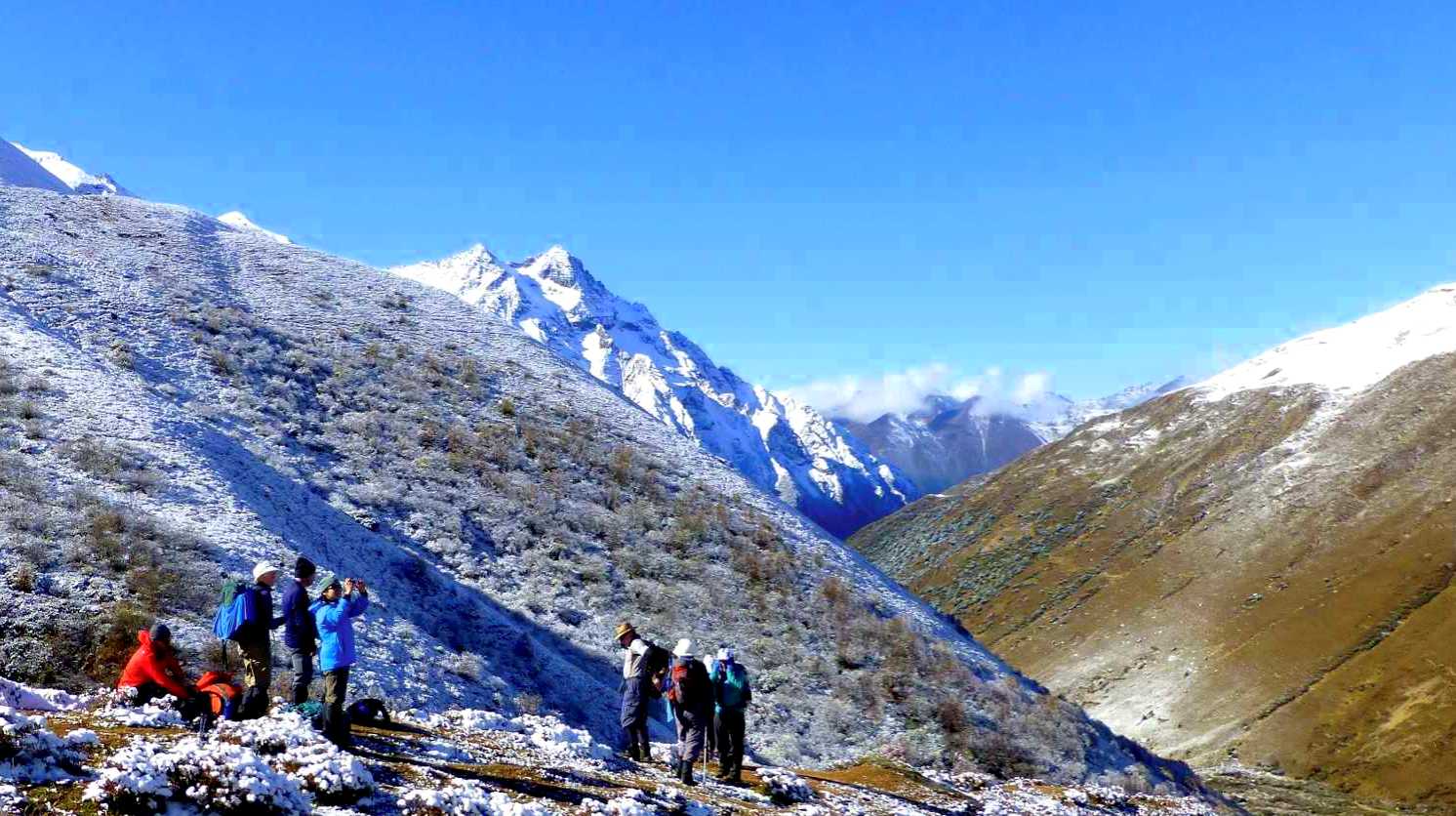
Overview
- Duration: Typically 25 to 30 days
- Distance: About 200 miles (320 kilometers)
- Best Season: The trek is best undertaken in October or late September to avoid heavy snows that can block mountain passes.
Difficulty
The Snowman Trek is considered extremely challenging due to its length, high altitude, and often unpredictable weather conditions. The trek crosses numerous passes over 5,000 meters, with the highest point being Rinchen Zoe La at 5,320 meters. The physical demands and the need for proper acclimatization make it suitable only for very experienced trekkers.
Route
Starting usually from Paro, the trek heads northwest up the Paro Chu and then the Pa Chu before reaching Lingshi, providing spectacular views of Jomolhari. It then continues through the Lunana region, one of the most remote areas of Bhutan, and finally concludes in Bumthang or Sephu in the Trongsa district, depending on the specific route taken. The trek involves traversing isolated and rarely visited areas of Bhutan, crossing several high-altitude passes, and experiencing stark changes in weather.
Highlights
- Scenic Beauty: The trek offers unparalleled views of some of the most stunning and remote mountainscapes on Earth. Trekkers can see multiple peaks over 7,000 meters, including Gangkar Puensum, Bhutan's highest and the world's highest unclimbed peak.
- Remote Culture: The Snowman Trek passes through isolated villages and settlements in the Lunana region, where the way of life has remained largely unchanged for centuries. This provides a unique cultural experience distinct from any other part of Bhutan or the Himalayas.
- Biodiversity: The route traverses diverse ecosystems, from lush valleys to arid high-altitude zones, home to a variety of wildlife including blue sheep, marmots, and the elusive snow leopard.
Considerations
- Logistics: Due to its length and the remote territory it covers, the Snowman Trek requires careful planning and support. Trekkers must arrange their journey through a registered tour operator in Bhutan, who will handle permits, guides, porters, and food supplies.
- Cost: The cost is significant, reflecting the length of the trek, the need for skilled support personnel, and the daily tariff imposed by the Bhutanese government, which includes accommodation, food, transportation, and a licensed Bhutanese tour guide.
- Weather: The weather can be highly unpredictable and can change from sunny and clear to snowing within a few hours, which can impact the trek's schedule and safety.
The Snowman Trek is a commitment to one of the most demanding physical and mental challenges available to trekkers worldwide. It offers not only the natural and cultural beauty of Bhutan but also a profound test of endurance and adventure.
Jomolhari Trek
The Jomolhari Trek is one of Bhutan’s most popular and spectacular high-altitude treks, offering both stunning natural landscapes and a unique insight into the local culture. Known for its breathtaking views of Mount Jomolhari, this trek appeals to a wide range of trekkers, from seasoned adventurers to those seeking a culturally enriching experience.
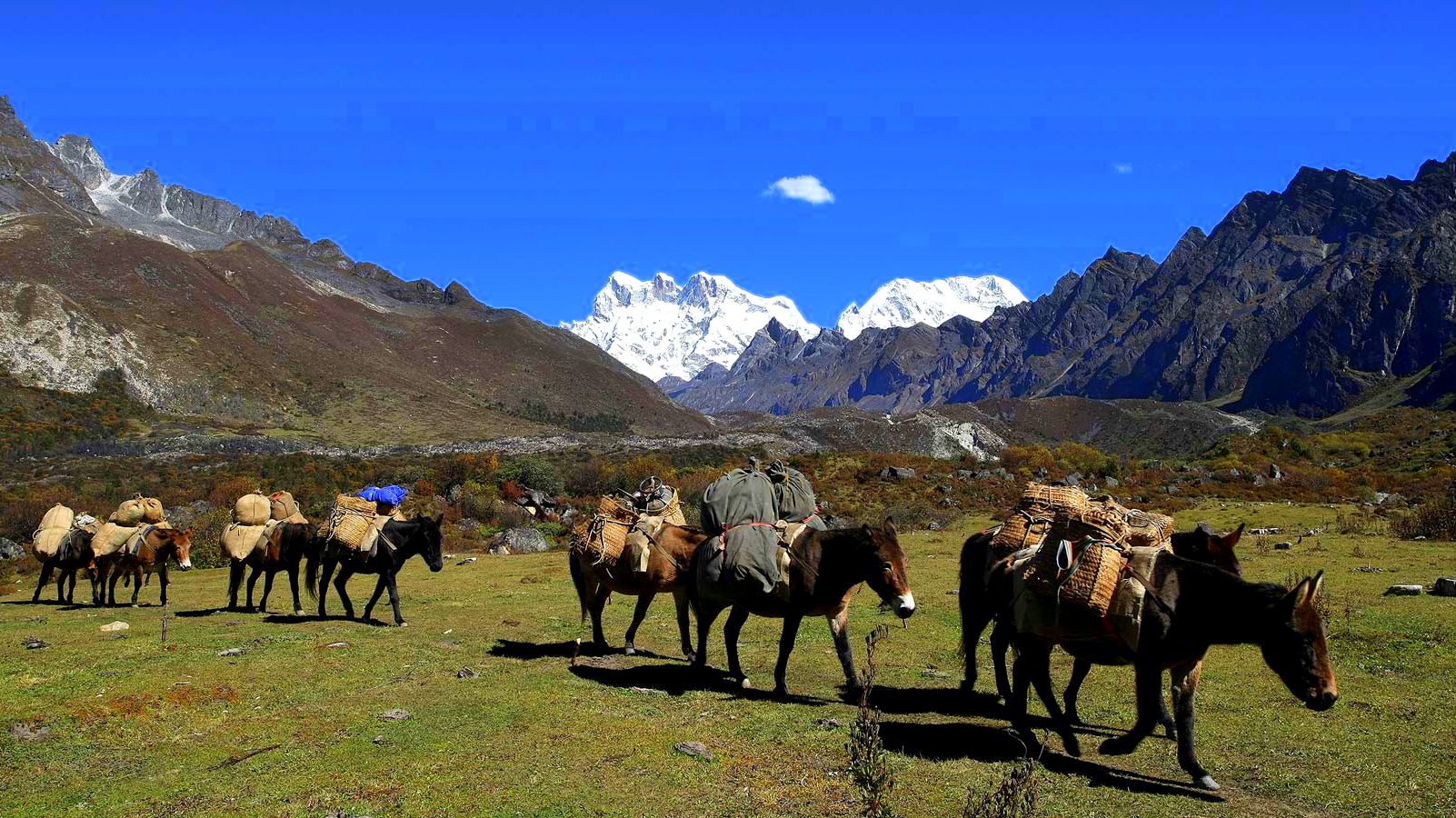
Overview
- Duration: Typically 7 to 9 days
- Distance: Approximately 115 kilometers
- Best Season: The best times to embark on the Jomolhari Trek are from late March to June and from September to November, when the weather is generally clear and stable.
Difficulty
The Jomolhari Trek is considered moderate to challenging. It requires good physical fitness as it involves long trekking days and crossing high mountain passes, including the Nyile La pass at 4,890 meters and the Yale La pass at 4,820 meters. The trek reaches its highest point at Jangothang, the base camp for Jomolhari, sitting at about 4,080 meters.
Route
The trek typically starts from Drukgyel Dzong in Paro. It follows the Paro River upstream through cultivated fields and small villages before entering a forested area filled with numerous ancient lhakhangs (temples) and chortens (stupas). The route then climbs up to the high pasturelands where yak herders graze their animals and continues to Jangothang, which offers one of the most stunning views of Jomolhari (7,326 meters). The return may follow the same path back or take a slightly different route through Bonte La, another high pass, which leads to a circuit finish.
Highlights
- Mount Jomolhari Views: One of the biggest draws of this trek is the incredible close-up view of Jomolhari from the base camp at Jangothang.
- Varied Landscapes: The trek traverses a remarkable variety of landscapes, from lush valleys and forests to high alpine pasturelands and rugged mountain passes.
- Wildlife and Flora: Trekkers might spot blue sheep, marmots, and if very lucky, the elusive snow leopard. The area is also known for its diverse flora, including blue poppies, Bhutan’s national flower.
- Cultural Experience: Passing through traditional Bhutanese villages and visiting remote temples and monasteries offer an authentic glimpse into the local way of life and spiritual practices.
Considerations
- Acclimatization: Proper acclimatization is crucial due to the high altitudes reached during this trek. Trekkers should allow time to adjust to the elevation, particularly at Jangothang.
- Preparation: Adequate preparation in terms of physical conditioning and proper gear is essential for the challenging conditions, particularly given the remote nature of the trek.
- Permits and Guides: As with all treks in Bhutan, visitors must arrange their trip through a registered tour operator. The trek requires a special permit, as it traverses the border area near Tibet.
The Jomolhari Trek not only challenges trekkers physically but also offers an enriching experience through the serene and majestic landscapes of Bhutan. It’s an ideal adventure for those who wish to combine high-altitude trekking with cultural immersion.
Laya Gasa Trek
The Laya Gasa Trek is one of the more scenic and culturally fascinating treks in Bhutan, extending the popular Jomolhari Trek into the remote regions of Laya and Gasa. This trek is well known for its stunning landscapes, ranging from lush forests to high alpine pastures, and offers trekkers a unique opportunity to explore the distinctive culture of the Layap people, the indigenous inhabitants of these highlands.
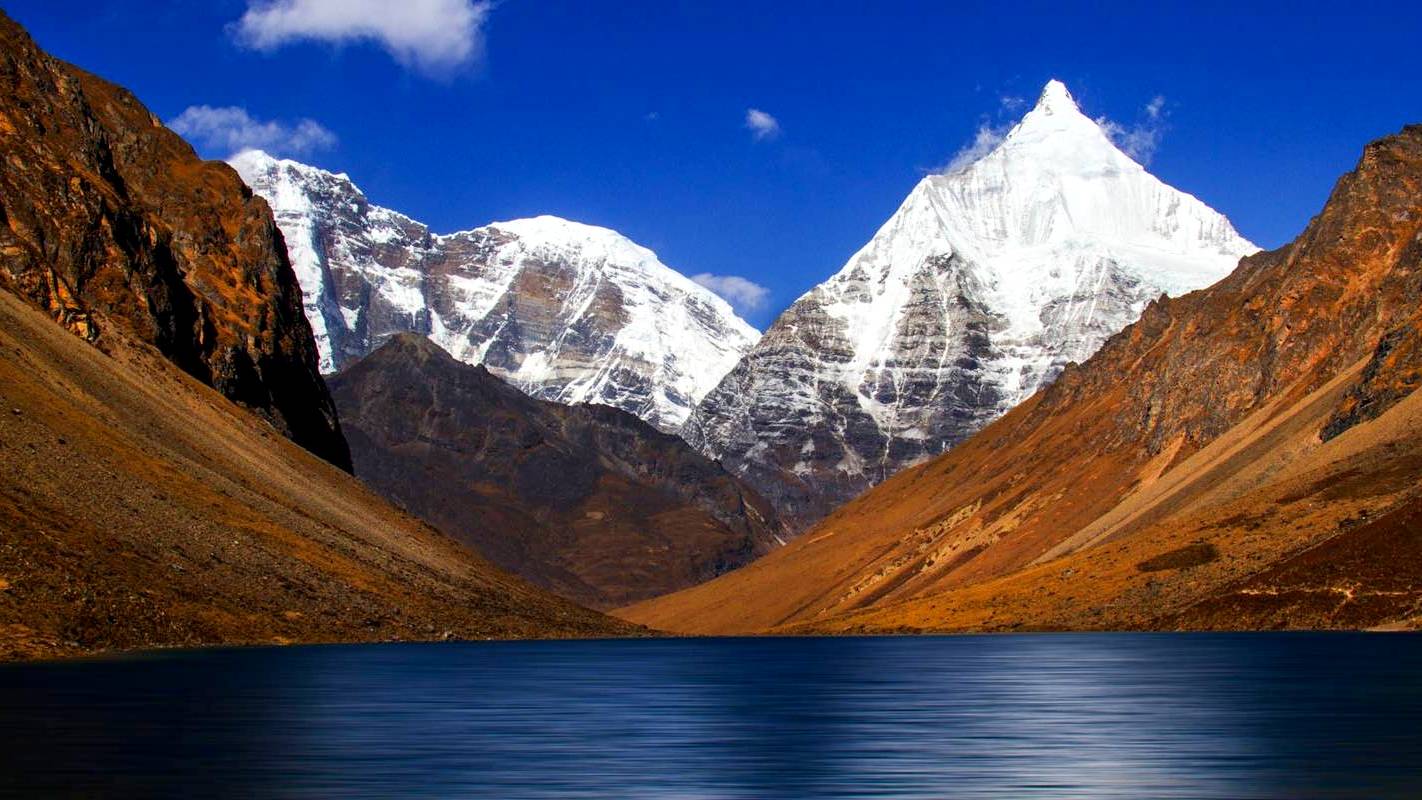
Overview
- Duration: Typically 10 to 14 days
- Distance: About 217 kilometers
- Best Season: The best times to undertake the Laya Gasa Trek are during the spring (April to June) and fall (September to November) when the weather is most favorable for trekking.
Difficulty
The Laya Gasa Trek is considered challenging due to its length, altitude, and the remote nature of the trail. It involves crossing several high passes, with the highest being the Sinche La pass at 5,005 meters. The trek requires good physical fitness and prior trekking experience, especially at high altitudes.
Route
The trek starts from Drukgyel Dzong in Paro, similar to the Jomolhari Trek. It follows the same trail up to Lingshi and then diverges towards the unique and culturally distinct region of Laya. From Laya, the trail continues to the hot springs at Gasa, another highlight of the trek, before descending to the road head at Damji.
Highlights
- Diverse Ecosystems: From dense forests and serene rivers to high-altitude pastures, the trek traverses a variety of beautiful landscapes that are home to an array of flora and fauna.
- Cultural Interaction: The trek provides an excellent opportunity to interact with the Layap people, known for their unique customs, clothing, and lifestyle, which are distinctly different from those in other parts of Bhutan.
- Therapeutic Hot Springs: One of the major attractions towards the end of the trek is the famous Gasa hot springs, believed to have therapeutic properties and a perfect way to relax after the strenuous journey.
- Remote Beauty: The Laya Gasa Trek offers more solitude compared to other popular treks in Bhutan. Its remote paths provide a true escape into nature.
- Impressive Views: Stunning views of the peaks, including Jomolhari, Jichu Drake, and Tsherimgang, are visible along different parts of the trek.
Considerations
- Acclimatization: Given the high altitudes and the rigorous nature of the trek, proper acclimatization is crucial to avoid altitude sickness.
- Preparation and Gear: Trekkers need to be well-prepared with the right gear, including appropriate clothing for cold and possibly snowy conditions, and sturdy hiking boots.
- Permits and Guides: As with all treks in Bhutan, the Laya Gasa Trek requires that arrangements be made through a registered Bhutanese tour operator. This includes obtaining necessary permits, hiring experienced guides, and organizing logistical support.
The Laya Gasa Trek is ideal for those looking to experience both the natural beauty and the unique cultural heritage of Bhutan. It is a challenging but rewarding journey that offers deep insights into the traditional lifestyles of some of Bhutan's most isolated communities, set against the backdrop of the country's most stunning and untouched landscapes.
Druk Path Trek
The Druk Path Trek is one of the most popular treks in Bhutan, offering a beautiful mix of natural and cultural sights within a relatively short period. It’s known for its scenic beauty, featuring pristine lakes, stunning views of the Himalayan peaks, and the picturesque landscape that transitions between the Paro and Thimphu valleys. This trek provides a wonderful opportunity to experience the great outdoors without venturing into extremely remote or challenging terrains.
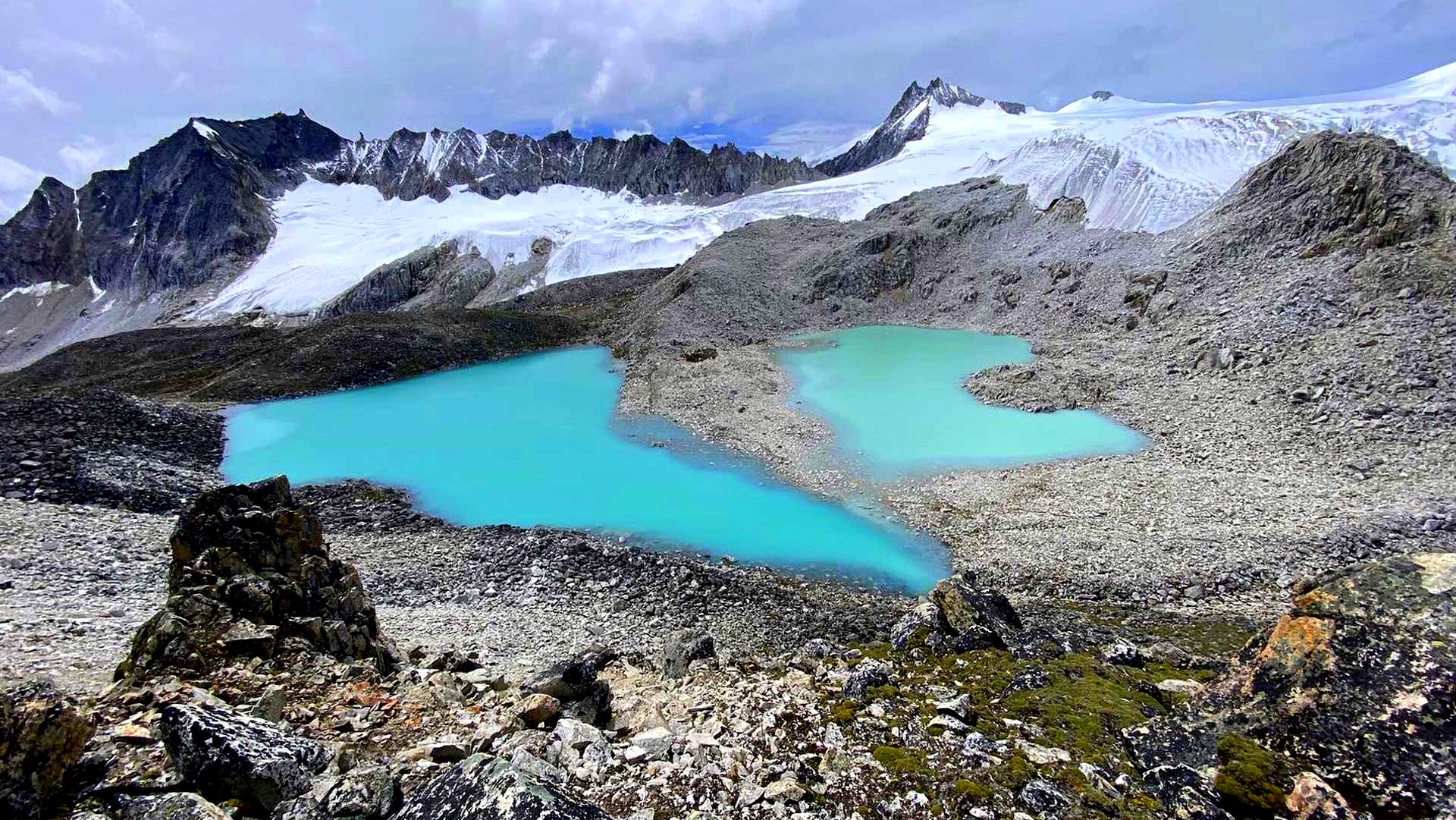
Overview
- Duration: Typically 6 to 8 days
- Distance: About 55 kilometers
- Best Season: The best times to undertake the Druk Path Trek are in the spring (March to May) and fall (September to November) when the weather is clear and the views are spectacular.
Difficulty
The Druk Path Trek is considered moderate in difficulty. It involves walking up and down a moderate gradient with a maximum elevation of around 4,210 meters at the Phume La pass. It is well-suited for those who are relatively fit and perhaps new to high-altitude trekking, looking to enjoy a genuine Himalayan experience without the extreme challenges of some longer treks.
Route
The trek usually starts from Paro, near Ta Dzong, and heads towards Jele Dzong. From there, the path rises to Jangchulakha and then to Jimilangtsho Lake, where trekkers often camp beside its famous trout-filled waters. The trek then proceeds to Simkotra Tsho Lake and finally crosses the Phume La pass, descending towards Phajoding Monastery before finishing in the capital city, Thimphu.
Highlights
- Varied Landscapes: The trek passes through a diverse range of forested landscapes, from blue pine to juniper, as well as alpine meadows that offer a beautiful display of wildflowers in the spring.
- Mountain Lakes: It features several stunning high-altitude lakes, each with its own unique setting and folklore. The most famous of these is Jimilangtsho Lake, known for its size and the large trout that populate its waters.
- Panoramic Views: Spectacular views of the eastern Himalayas, including Bhutan’s highest mountain, Gangkar Puensum, and other famous peaks like Mount Jomolhari, are key features of this trek.
- Cultural Sites: The route includes visits to ancient lhakhangs (temples) and dzongs (fortresses), providing a cultural depth to the natural hike. The trek also offers the opportunity to visit Phajoding Monastery, which is considered one of the most sacred monastic sites in Bhutan.
- Accessibility and Convenience: This trek is conveniently bookended by Bhutan’s two most prominent towns, Paro and Thimphu, making it easy to organize and access, and it does not require extended periods away from comfortable accommodations.
Considerations
- Acclimatization: Although not as high as other treks, altitude sickness can still be a concern due to the quick ascent. Adequate acclimatization days should be planned.
- Weather Conditions: Weather can be quite variable, even within a single day, from sunny and warm to cold and windy, especially at the higher passes.
- Preparation: Despite its moderate challenge, proper preparation is essential, including physical conditioning and carrying the right gear for cold and potentially rainy conditions.
The Druk Path Trek is an excellent choice for those looking to experience the beauty of the Bhutanese Himalayas within a limited timeframe. It offers a blend of natural beauty, with its lakes and views, and cultural experiences, making it a fulfilling adventure for both new and experienced trekkers.
Gangtey Trek
The Gangtey Trek, also known as the Phobjikha Trek, is a relatively easy and short trek in Bhutan that showcases the stunning beauty and ecological richness of the Phobjikha Valley. This valley is renowned for its scenic splendor and cultural significance, primarily as the winter home of the rare black-necked cranes. The trek provides a wonderful blend of natural landscape, wildlife viewing, and cultural exposure, making it an ideal choice for those looking for a less strenuous trekking experience in Bhutan.
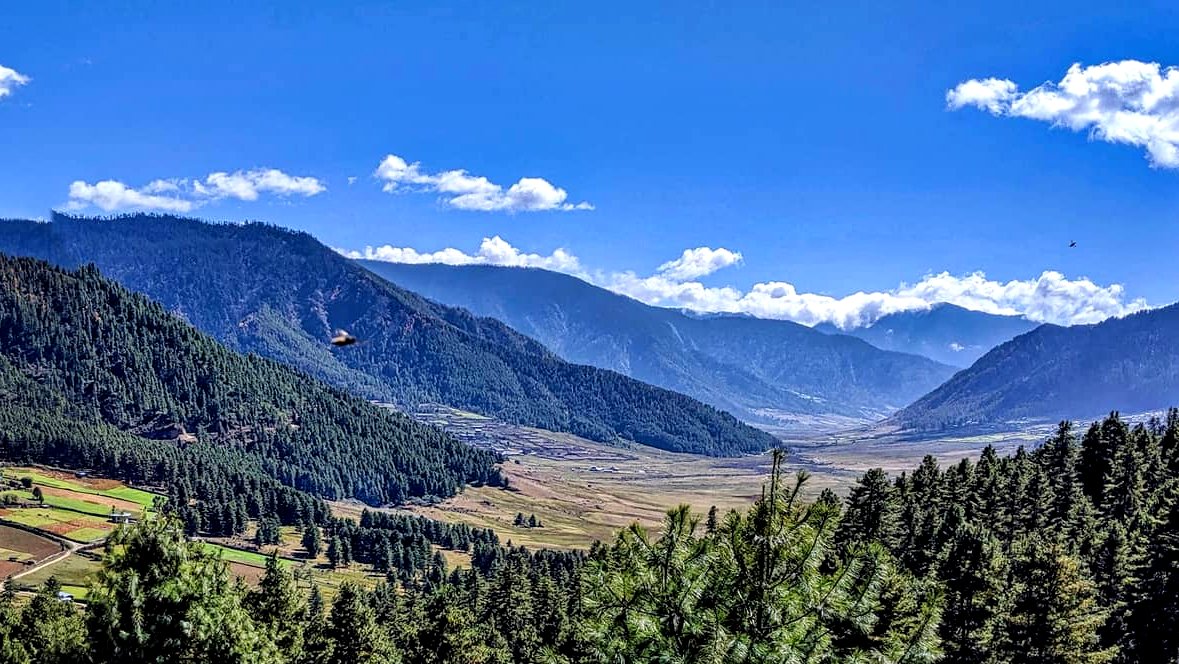
Overview
- Duration: Typically 3 to 5 days
- Distance: About 54 kilometers
- Best Season: The best times to undertake the Gangtey Trek are in spring (March to May) and autumn (September to November), with a special highlight in the winter months when the black-necked cranes are present.
Difficulty
The Gangtey Trek is considered easy to moderate, involving mainly gentle walks through meadows and valleys with no significant high-altitude climbs. It is suitable for trekkers of all levels, including families and those without prior trekking experience, looking for a peaceful hike through one of Bhutan’s most beautiful landscapes.
Route
The trek starts from the village of Phobjikha, which is one of the few glacial valleys in Bhutan and lies on the periphery of the Black Mountains National Park. The route takes trekkers through rhododendron forests, open meadows, and small rural villages, providing insights into the rural Bhutanese lifestyle. The path then circles back to Phobjikha, allowing trekkers to explore different facets of the valley.
Highlights
- Phobjikha Valley: Known for its breathtaking natural scenery and the winter habitat of the black-necked cranes that migrate here from Tibet. The valley is a significant wildlife preserve and offers excellent opportunities for bird watching.
- Cultural Experience: The trek includes a visit to the Gangtey Goemba, an important monastery dating back to the 17th century. This provides an excellent cultural insight into the spiritual life of the Bhutanese people.
- Ecological Richness: The area is a designated conservation zone and a vital part of the Black Mountains National Park, known for its rich biodiversity.
- Scenic Landscapes: Gentle rolling hills and open meadows provide panoramic views and photographic opportunities, making it a visually appealing trek.
- Wildlife: In addition to the famous black-necked cranes, the region is home to a variety of other wildlife, including wild boars, sambars, and leopards.
Considerations
- Weather Conditions: The weather in Phobjikha Valley can be unpredictable, so it’s advisable to be prepared for sudden changes, particularly if trekking outside of the recommended seasons.
- Accessibility: The trek is relatively accessible due to its gentle terrain and the availability of basic amenities along the route.
- Wildlife Regulations: Given the ecological sensitivity of the valley, particularly concerning the black-necked cranes, trekkers should be mindful of the guidelines and restrictions aimed at protecting the wildlife and their habitat.
The Gangtey Trek is a fantastic choice for those interested in a tranquil trekking experience that combines natural beauty, wildlife observation, and cultural immersion. Its easy terrain and short duration make it accessible to a wide range of trekkers, offering a refreshing and enlightening outdoor adventure in the heart of Bhutan.
Important Tips for the high-altitude trek in Bhutan
Trekking at high altitudes in Bhutan can be an exhilarating yet challenging experience, especially given the rugged terrain and the elevations that often exceed 4,000 meters. Proper preparation is essential to ensure a safe and enjoyable adventure. Here are some important tips to consider when planning a high-altitude trek in Bhutan:
Acclimatization
- Take It Slow: Allow your body time to adjust to the higher altitudes. Plan for acclimatization days in your itinerary, especially before tackling any passes above 4,000 meters.
- Recognize Altitude Sickness Symptoms: Be aware of the symptoms of altitude sickness, which can include headache, nausea, dizziness, and fatigue. If symptoms appear, it's essential to descend to a lower altitude and seek medical help if necessary.
Physical Preparation
- Get Fit: High-altitude trekking can be physically demanding. Engage in cardiovascular training such as hiking, running, or cycling months before your trip to build endurance.
- Train with Gear: Practice hiking with the backpack you will be using, gradually increasing the weight to simulate the load you will carry during the trek.
Packing Essentials
- Layered Clothing: Weather can change rapidly at high altitudes. Pack layers of moisture-wicking and thermal clothing to adapt to varying temperatures.
- Proper Footwear: Invest in a good pair of waterproof, sturdy trekking boots, and break them in well before the trek to avoid blisters.
- Sun Protection: Bring high-SPF sunscreen, lip balm, sunglasses, and a wide-brimmed hat to protect against the sun, which can be particularly intense at higher elevations.
Navigation and Guides
- Hire a Guide: Regulations require that you trek with a licensed Bhutanese guide. Guides are invaluable for their knowledge of the terrain, weather conditions, and local culture.
- Maps and GPS: Carry detailed maps and a GPS device for additional navigation support, though your guide should handle the primary navigation.
Nutrition and Hydration
- Stay Hydrated: Drink plenty of water throughout the trek. Dehydration can increase the risk of altitude sickness.
- Balanced Diet: Eat meals rich in carbohydrates for energy. Your tour operator will generally arrange food, but you may want to bring along some of your favorite high-energy snacks.
Insurance and Safety
- Travel Insurance: Ensure that your travel insurance covers high-altitude trekking and medical evacuation, which is crucial for remote regions.
- Emergency Plan: Know the emergency procedures. Carry a basic first aid kit and understand how to use each item.
Respect Local Customs and Environment
- Cultural Sensitivity: Respect the local customs and traditions. Dress modestly and ask permission before photographing people.
- Environmental Impact: Follow the principles of Leave No Trace. Keep the trails clean, dispose of waste properly, and minimize your ecological footprint.
Legal and Logistical Considerations
- Permits and Documentation: Ensure all your documents and permits are in order, as these will be checked at various points along the trek.
- Communications: Consider renting a satellite phone for areas where mobile coverage is unreliable.
By following these tips and preparing thoroughly, you can ensure that your high-altitude trek in Bhutan is not only memorable but also safe and respectful of both the natural environment and the local communities.
A high-altitude trek in Bhutan is an enriching experience that combines the physical challenge of mountain trekking with the spiritual and cultural discovery of one of the world’s most secluded and unspoiled regions. By adequately preparing for the rigors of high-altitude hiking, respecting local customs and the natural environment, and ensuring you have the right gear and guidance, you can fully embrace the majesty and mystique of Bhutan’s mountainous landscapes. Whether you are navigating the remote trails of the Snowman Trek or soaking in the panoramic views on the Druk Path, each step offers a unique opportunity to connect with nature and immerse yourself in the spiritual heartbeat of the Himalayas. With careful planning and a spirit of adventure, your trek through the clouds in Bhutan will not just be a journey through breathtaking landscapes but a lifelong memory that broadens the horizons of your world.
FAQs of the Trekking through the Clouds: Bhutan's High-Altitude Adventures
Q. What is the best time of year to go trekking in Bhutan?
A. The best seasons for trekking in Bhutan are spring (March to May) and autumn (September to November). These months typically offer clear skies, stable weather, and the best views of the Himalayan peaks. The monsoon season (June to August) is less ideal due to heavy rains and potential trail washouts.
Q. Do I need a guide to trek in Bhutan?
A. Yes, all trekking tours in Bhutan must be arranged through a registered tour operator and accompanied by a licensed Bhutanese guide. This regulation ensures both the safety of trekkers and the preservation of Bhutan's natural and cultural heritage.
Q. How difficult are the treks in Bhutan?
A. The difficulty level varies by trek. Some treks, like the Jomolhari Trek, are moderate and suitable for trekkers who are in good health and have some trekking experience. Others, like the Snowman Trek, are considered extremely challenging and are only recommended for very experienced trekkers in excellent physical condition.
Q. What should I pack for a high-altitude trek in Bhutan?
A. Essential items include layered clothing for varying temperatures, waterproof gear, a good quality sleeping bag, a durable backpack, trekking boots, a hat and gloves, sunscreen, sunglasses, a personal first aid kit, and any personal medication. It’s also advisable to carry high-energy snacks and a reusable water bottle.
Q. How do I acclimate to high altitudes?
A. Acclimatization can be facilitated by spending several days at a moderate elevation and ascending gradually to higher altitudes. Your itinerary should include acclimatization days, particularly before reaching the highest parts of the trek. Listen to your body, stay hydrated, and inform your guide if you feel unwell.
Q. Are there any cultural customs I should be aware of while trekking in Bhutan?
A. Yes, Bhutan has strong cultural traditions. Dress modestly, remove your shoes before entering religious sites, and always ask permission before taking photographs of people or religious festivals. It’s also customary to walk clockwise around religious monuments and chortens.
Q. What are the risks of high-altitude trekking in Bhutan?
A. The main risks include altitude sickness, sudden weather changes, and remote terrain. Ensure you have travel insurance that covers high-altitude trekking and emergency evacuation. Follow your guide’s advice, prepare for cold and wet conditions, and carry essential navigation and communication devices.
Q. How much does it cost to trek in Bhutan?
A. Trekking in Bhutan requires paying a minimum daily package rate set by the government, which covers accommodation, meals, a licensed guide, and transportation, as well as a sustainable tourism royalty. The cost typically starts at $200 per person per day during low season and $250 per day during high season, with additional charges for trekking arrangements.
Q. Can I trek independently in Bhutan?
A. Independent trekking is not allowed in Bhutan. All treks must be arranged through a Bhutanese tour operator and accompanied by a licensed guide.
Q. What wildlife might I see during the trek?
A. Depending on the trek, you might see blue sheep, takin (the national animal of Bhutan), various bird species including the Himalayan monal, and perhaps even the elusive snow leopard in more remote areas.


